Avoiding The Product Death Cycle Trap
In the world of product management, it’s easy to fall into the trap of the “product death cycle.” Many product managers forget the importance of the “Why” and end up becoming mere “facilitators,” collecting and implementing feature requirements without considering the broader vision and strategy. This approach often leads to rushed deliveries that fail to solve problems or drive desired business results. However, there are some strategies to prevent or escape this trap and build great products that align with user needs and business objectives. Some of them are:

Product Death Cycle By David J Bland
Always Remember Your Product’s Vision and Strategy
To prevent the product death cycle, it’s crucial to maintain a clear focus on your product’s vision and strategy. You need to ask yourself important questions that align your product’s purpose with the company’s overall direction. Some of those questions may look like this:
Why are you building this product?
How does it solve the user’s problem?
Who are your users?
What are the desired user results whether it’s functional, emotional, or social?
What’s its unique value proposition?
How does it fit with the company’s vision and strategy?
What value it will create for the business and it will do that?
What does the path to success look like for the product?
Avoid Letting Users Design Solutions
While understanding user problems and needs is crucial, it’s important to avoid relying solely on customers to design solutions. Instead, focus on in-depth understanding through regular interviews, opportunity mapping, and brainstorming sessions involving designers and engineers. This collaborative approach helps build a shared understanding and allows for diverse perspectives plus also inculcates a product culture in the organization where everybody feels like they are building something meaningful.
Be Ready To Question Imposed Solutions
While respecting stakeholders’ authority, it’s essential to question solutions and push back on decisions that may not align with what’s important. This requires having uncomfortable conversations and advocating for what truly matters.
That’s where Influencing without authority comes in handy. You can read more about it here.
Test Ideas with MVPs and Prototypes
Run small experiments and validate ideas through minimum viable products (MVPs) and prototypes before running into full-scale product development. This approach allows you to assess feasibility, usability, value, viability, and ethical considerations before investing significant resources. You can read more about it here.
As product managers, our goal is to build products that user love, address their needs, and drive business success. By following these strategies and embracing a user-centric, vision-driven approach, you can escape the product death cycle and build meaningful products for the users.